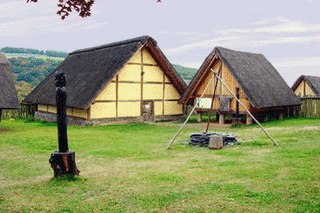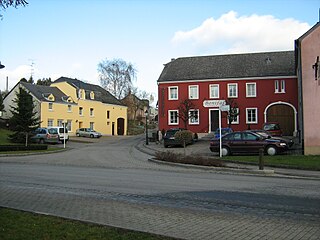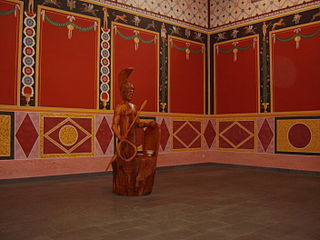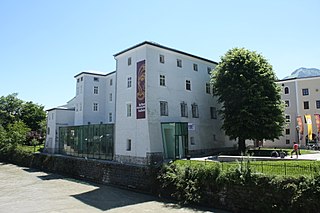
The Celts are a collection of Indo-European peoples in parts of Europe and Anatolia identified by their use of the Celtic languages and other cultural similarities. Historic Celtic groups included the Gauls, Celtiberians, Gallaecians, Galatians, Britons, Gaels, and their offshoots. The relationship between ethnicity, language and culture in the Celtic world is unclear and controversial. In particular, there is dispute over the ways in which the Iron Age inhabitants of Britain and Ireland should be regarded as Celts.

The La Tène culture was a European Iron Age culture. It developed and flourished during the late Iron Age, succeeding the early Iron Age Hallstatt culture without any definite cultural break, under considerable Mediterranean influence from the Greeks in pre-Roman Gaul, the Etruscans, and Golasecca culture, but whose artistic style nevertheless did not depend on those Mediterranean influences.

In Gallo-Roman religion, Ancamna was a goddess worshipped particularly in the valley of the Moselle River. She was commemorated at Trier and Ripsdorf as the consort of Lenus Mars, and at Möhn as the consort of Mars Smertulitanus. At Trier, altars were set up in honour of Lenus Mars, Ancamna and the genii of various pagi of the Treveri, giving the impression of Lenus Mars and Ancamna as tribal protectors honoured in an officially organized cult. Among the few statuettes left as votive offerings left at the sanctuary of Mars Smertulitanus and Ancamna at Möhn is one of a genius cucullatus like those offered to the Xulsigiae at the Lenus Mars temple complex in Trier.
In Gallo-Roman religion, Arduinna was the eponymous tutelary goddess of the Ardennes Forest and region, thought to be represented as a huntress riding a boar. Her cult originated in the Ardennes region of present-day Belgium, Luxembourg, and France. She was identified with the Roman goddess Diana.

A torc, also spelled torq or torque, is a large rigid or stiff neck ring in metal, made either as a single piece or from strands twisted together. The great majority are open at the front, although some had hook and ring closures and a few had mortice and tenon locking catches to close them. Many seem designed for near-permanent wear and would have been difficult to remove. Torcs are found in the Scythian, Illyrian, Thracian, Celtic, and other cultures of the European Iron Age from around the 8th century BC to the 3rd century AD. For the Iron Age Celts, the gold torc seems to have been a key object. It identifies the wearer as a person of high rank, and many of the finest works of ancient Celtic art are torcs. The Celtic torc disappears in the Migration Period, but during the Viking Age torc-style metal necklaces, now mainly in silver, came back into fashion. Torc styles of neck-ring are found as part of the jewellery styles of various other cultures and periods.

The Bituriges Cubi were a Gallic tribe dwelling in the later province of Berry during the Iron Age and the Roman period. They had a homonym tribe, the Bituriges Vivisci, in the Bordelais region, which could indicate a common origin, although there is no direct evidence of this.

The Treveri or Treviri were a Celtic tribe of the Belgae group who inhabited the lower valley of the Moselle from around 150 BCE, if not earlier, until their displacement by the Franks. Their domain lay within the southern fringes of the Silva Arduenna, a part of the vast Silva Carbonaria, in what are now Luxembourg, southeastern Belgium and western Germany; its centre was the city of Trier, to which the Treveri give their name. Celtic in language, according to Tacitus they claimed Germanic descent. They possibly contained both Gallic and Germanic influences.

Clemency is a town and a former commune in south-western Luxembourg. Since 2012, it is part of the commune of Käerjeng. It is part of the canton of Capellen, which is part of the district of Luxembourg.

Bertrange is a commune and town in south-western Luxembourg. It is located 6.5 km west of Luxembourg City.

Nospelt is a village in the commune of Kehlen, in south-western Luxembourg. As of 2005, the village had a population of 754. It is known above all for its potters who were particularly successful during the 19th century.

Goeblange is a village in the commune of Koerich, in southern Luxembourg about 13 km west of Luxembourg City. As of 2005, the village had a population of 425.

Prehistoric Wales in terms of human settlements covers the period from about 230,000 years ago, the date attributed to the earliest human remains found in what is now Wales, to the year AD 48 when the Roman army began a military campaign against one of the Welsh tribes. Traditionally, historians have believed that successive waves of immigrants brought different cultures into the area, largely replacing the previous inhabitants, with the last wave of immigrants being the Celts. However, studies of population genetics now suggest that this may not be true, and that immigration was on a smaller scale.

The prehistory of Ireland has been pieced together from archaeological evidence, which has grown at an increasing rate over the last decades. It begins with the first evidence of permanent human residence in Ireland around 10,500 BC, though an earlier date of 31,000 BC, for perhaps temporary hunting incursions, has been suggested following a 21st-century reexamination of a butchered reindeer bone discovered in 1905 at Castlepook Cave, County Cork, and finishes with the start of the historical record around 400 AD. Both the beginning and end dates of the period are later than for much of Europe and all of the Near East. The prehistoric period covers the Palaeolithic, Mesolithic, Neolithic, Bronze Age and Iron Age societies of Ireland. For much of Europe, the historical record begins when the Romans invaded; as Ireland was not invaded by the Romans its historical record starts later, with the coming of Christianity.

Lenus was a Celtic healing god worshipped mainly in eastern Gaul, where he was almost always identified with the Roman god Mars. He was an important god of the Treveri tribe, who had large sanctuaries at medicinal springs at Trier and the Martberg by Pommern in what is now Germany. Two dedications to him are also known from southwestern Britain. Edith Wightman characterizes him as “one of the best examples of a Teutates, or god of the people, equated with Mars—protector of the tribe in battle, but also [...] bestower of health and general good fortune” (p. 211). His sanctuary ‘Am Irminenwingert’ at Trier had a large temple, baths, smaller shrines and a theatre; that on the Martberg also included a large variety of buildings, probably including rooms for health-seeking pilgrims to stay. Despite his associations with healing, Lenus Mars is depicted classically as a warrior with Corinthian helmet in a bronze statuette from the Martberg.

Veraudunus is the name of a Celtic god known only from two votive inscriptions found in Luxembourg. One of these inscriptions suggests that ‘Veraudunus’ may have been an epithet of the important Treveran god Lenus Mars. In both inscriptions, Veraudunus is invoked along with Inciona.

Titelberg is the site of a large Celtic settlement or oppidum in the extreme south west of Luxembourg. In the 1st century BC, this thriving community was probably the capital of the Treveri people. The site thus provides telling evidence of urban civilization in the century before the Roman conquest.

The Musée d'Archéologie nationale is a major French archeology museum, covering pre-historic times to the Merovingian period. It is located in the Château de Saint-Germain-en-Laye in the département of Yvelines, about 19 kilometres (12 mi) west of Paris.

The architecture of Luxembourg probably extends back to the Treveri, a Celtic tribe who prospered in the 1st century BC. A few ruins remain from the Roman occupation but the most significant contributions over the centuries have been the country's castles and churches. Today there is a veritable architectural boom as Luxembourg's economic prosperity provides a basis for developments in the financial, EU and cultural sectors with a number of world-class buildings.

The Keltenmuseum in Hallein near Salzburg contains major discoveries from the La Tene period of the Iron Age which come from burials in the area surrounding the nearby Hallein Salt Mine, at Dürrnberg. The Museum was founded in 1882 and was housed in the Bürgerspital. In 1930 it was moved into the Rathaus and from 1952 occupied a gateway of the town or stadt's fortifications. In 1970 the name was changed to Keltenmuseum and the museum was moved into the former Salt Offices on the Pflegerplatz, which fronts the river Salzach. In 1980 the Museum staged a major exhibition "Die Kelten in Mitteleuropa", which demonstrated the wealth of discoveries that were being made at the Hallein. In 1993-4 the Austrian architect Heinz Tesar drew up plans for the conversion and extension of the Museum and on 1 January 2012 the Museum became a constituent part of Salzburg Museum.
The Hunsrück-Eifel Culture is an Iron Age cultural group of the Middle Rhine region of western Germany (Rhineland-Palatinate) and eastern Belgium and Luxembourg. The names "Hunsrück" and "Eifel" refer to a pair of low mountain ranges covering most of the region.


















